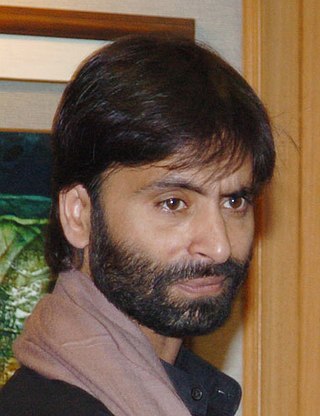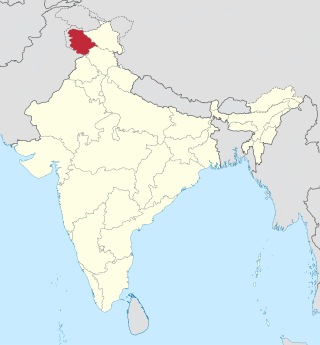
The insurgency in Jammu and Kashmir, also known as the Kashmir insurgency, is an ongoing separatist militant insurgency against the Indian administration in Jammu and Kashmir, a territory constituting the southwestern portion of the larger geographical region of Kashmir, which has been the subject of a territorial dispute between India and Pakistan since 1947.

Yasin Malik is a Kashmiri separatist leader and former militant who advocates the separation of Kashmir from both India and Pakistan. He is the Chairman of the Jammu Kashmir Liberation Front, which originally spearheaded armed militancy in the Kashmir Valley. Malik renounced violence in 1994 and adopted peaceful methods to come to a settlement of the Kashmir conflict. In May 2022, Malik pleaded guilty to charges of criminal conspiracy and waging war against the state, and was sentenced to life imprisonment.
Asiya Andrabi is a Kashmiri separatist and founding leader of Dukhtaran-e-Millat. This group is part of the separatist organisation All Parties Hurriyat Conference in the Kashmir valley. Government of India has declared it as a "banned organization". The organisation claims that it aims for the freedom of Kashmir from India.
On 26 May 2008, the government of India and the state Government of Jammu and Kashmir reached an agreement to transfer 99 acres (0.40 km2) of forest land to the Shri Amarnathji Shrine Board (SASB) in the main Kashmir valley to set up temporary shelters and facilities for Hindu pilgrims to Amarnath Temple. This caused a controversy, with demonstrations from the Kashmir valley against the land transfer and protests from the Jammu region supporting it. The largest demonstration saw more than 500,000 protesters at a single rally, among the largest in Kashmir's history.

Lal Chowk is a city square in Srinagar, in the Indian union territory of Jammu and Kashmir.
Elections for the Indian state of Jammu and Kashmir were held over seven days in November and December 2008. The previous government led by the Jammu and Kashmir People's Democratic Party (PDP) in coalition with the Indian National Congress (INC) collapsed when the PDP withdrew. Following the election, the Jammu & Kashmir National Conference (NC) agreed on a coalition with Congress and their leader, Omar Abdullah became the state's youngest-ever Chief Minister at 38.

The 2010 Kashmir unrest was a series of violent protests and riots in the Kashmir Division and Northern Jammu Division of Jammu and Kashmir, India which started in June 2010 after the Indian Army claimed to have killed three Pakistani infiltrators in which a soldier of the Territorial Army, a counter-insurgent and a former special police officer had found three young men from their Nadihal village in Baramulla district and killed them in a "staged" encounter at Sona Pindi. The protests occurred in a movement launched by Hurriyat Conference led by Syed Ali Shah Geelani and Mirwaiz Umar Farooq in the Indian state of Jammu and Kashmir in June 2010, who called for the complete demilitarisation of Jammu and Kashmir. The All Parties Hurriyat Conference made this call to a strike, citing human rights abuses by security forces. Rioters shouting pro-independence slogans, defied curfew, attacked riot police with stones and burnt vehicles and buildings. The protests started out as anti India protests but later were also targeted against the United States following the 2010 Qur'an-burning controversy. The riot police consisting of Jammu and Kashmir Police and Indian Para-military forces fired teargas shells rubber bullets and also live ammunition on the protesters, resulting in 112 deaths, including many teenagers and an 11-year-old boy. The protests subsided after the Indian government announced a package of measures aimed at defusing the tensions in September 2010.
Human rights abuses in Kashmir have been perpetrated by various belligerents in the territories controlled by both India and Pakistan since the two countries' conflict over the region began with their first war in 1947–1948, shortly after the partition of British India. The organized breaches of fundamental human rights in Kashmir are tied to the contested territorial status of the region, over which India and Pakistan have fought multiple wars. More specifically, the issue pertains to abuses committed in Indian-administered Kashmir and in Pakistani-administered Kashmir.
Masarat Alam Bhat is a Kashmiri Islamist activist and Political separatist leader of Jammu and Kashmir. He is currently serving as the chairman of the Jammu Kashmir Muslim League, and also serves as the interim chairman of Geelani faction of the All Parties Hurriyat Conference.

Burhan Wani was a commander of Hizbul Mujahideen, an Islamist militant organization and insurgent group of the Kashmir conflict. He had become a popular figure amongst the local Kashmiri populace, having done so primarily through a strong social media presence, and was responsible for moulding the insurgency in Jammu and Kashmir into a youth-oriented movement. Wani was a militant leader and had reportedly recruited numerous foot-soldiers through his personal efforts.
Kashmir International Half Marathon, organized by Big FM, saw more than 30,000 people from India and other countries participate in the event which was held in Srinagar on 13 September 2015.

The 2016–2017 unrest in Kashmir, also known as the Burhan aftermath, refers to protests in the Indian state of Jammu and Kashmir, chiefly in the Kashmir Valley. It started after the killing of militan leader Burhan Wani by Indian security forces on 8 July 2016. Wani was a commander of the Kashmir-based Islamist militant organisation Hizbul Mujahideen.
Zakir Rashid Bhat was a Kashmiri separatist who became the commander of Hizbul Mujahideen after the killing of Burhan Wani and Sabzar Bhat, who were the former commanders of the same outfit. He later became the chief of Ansar Ghazwat-ul-Hind.
Kamran Yusuf, also known as Kamran Yousuf is a Kashmiri multimedia journalist. As of 2022, Kamran is a staffer at NewsClick. He also works as a freelance multimedia journalist for various international organisations. In 2017, he was booked under UAPA and lodged at Tihar Jail. Many national as well as international organisations including Committee to Protect Journalists, the International Federation of Journalists, Amnesty International and more issued statements for his immediate release. He got bail after six months and was discharged from all the charges on 16 March 2022 by Delhi court.
Shujaat Bukhari was a Kashmiri journalist and the founding editor of Rising Kashmir, a Srinagar-based newspaper.

Crowd control in Jammu and Kashmir is a public security practice to prevent and manage violent riots. It is enforced by police forces through laws preventing unlawful assembly, as well as using riot control agents such as tear gas, chili grenades, and pellet guns.

On 5 August 2019, the Government of India revoked the special status, or autonomy, granted under Article 370 of the Indian Constitution to Jammu and Kashmir—a region administered by India as a state which consists of the larger part of Kashmir which has been the subject of dispute among India, Pakistan, and China since 1947.

The 2019–2021 Jammu and Kashmir lockdown was a preventive security lockdown and communications blackout that had been imposed throughout the Indian-administered union territory of Jammu and Kashmir following the revocation of Article 370 which lasted until February 2021, with the goal of preemptively curbing unrest, violence and protests. Most separatist leaders had and have been detained in the crackdown. The Indian government had stated that the tough lockdown measures and substantially increased deployment of security forces had been aimed at curbing terrorism. The government did not want a repeat of the death and injuries seen during the 2016–2017 Kashmir unrest.
Stone pelting in India refers to criminal assault in the form of stone throwing by individuals or mob who pelt, bombard or throw stones at security personnel, police forces, healthcare workers and trains. Stone pelting began with incidents of stone pelting in Kashmir, but became less frequent after the revocation of article 370 of the Constitution of India and the conversion of the state into union territories. These incidents were later reported in Delhi and Uttar Pradesh in 2019 in protest of the citizenship amendment act. In 2020, such incidents started occurring in various parts of India on doctors and policemen after the coronavirus lockdown.
Kashmir human shield incident occurred on April 9, 2017 in Jammu and Kashmir during the Srinagar Lok Sabha by-election. A 26-year-old man captured by the Indian Army, was tied as a human shield to the front of a Jeep belonging to Indian Army as a column of Indian troops was moving through a locality. The man was reportedly tied to the vehicle to dissuade other Kashmiri protestors from hurling stones at the Indian troops. The man was accused of being involved in throwing stones at Indian troops. The Government of India stated that it would stand by the officer who decided to use the "insurgent" as a human shield.








